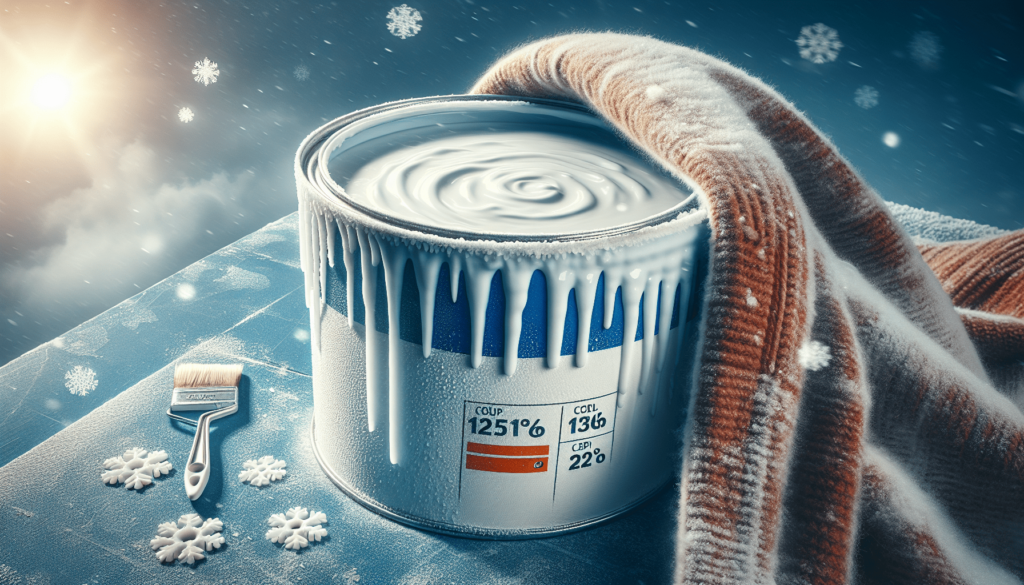Latex paint is a common choice for homeowners when it comes to giving their walls a fresh and vibrant appearance. However, have you ever wondered what happens to this type of paint when exposed to freezing temperatures? In this article, we will explore the question of whether or not latex paint freezes. By understanding the behavior of this popular paint option in cold conditions, you can ensure the longevity and quality of your paint job, regardless of the weather conditions it may face.

What is Latex Paint?
Latex paint, also known as acrylic paint, is a popular type of water-based paint that is commonly used for interior and exterior applications. It is known for its fast-drying properties, durability, and ease of use. Latex paint is made up of pigments, binders, and water, giving it its characteristic smooth and even finish. Compared to oil-based paint, latex paint is more environmentally friendly, has less odor, and is easier to clean up.
Composition
Latex paint is composed of three main components: pigments, binders, and water. Pigments provide color and opacity to the paint, while binders hold the pigments together and help the paint adhere to surfaces. Common binders used in latex paint include acrylic, vinyl acrylic, and styrene acrylic. Water acts as the solvent and gives latex paint its ability to be thinned and cleaned up easily. Additionally, latex paint may contain additives such as thickeners, surfactants, and preservatives to enhance its performance and shelf life.
Freezing Temperatures for Latex Paint
Temperature Threshold
The freezing temperature of latex paint varies depending on its formulation, but in general, latex paint can start to freeze at temperatures below 32 degrees Fahrenheit (0 degrees Celsius). At this temperature, the water component of the paint can begin to solidify, resulting in changes in consistency and performance.
Effect of Freezing on Latex Paint
When latex paint freezes, the water in the paint forms ice crystals, causing the paint to separate and clump together. This leads to a loss of uniformity and smoothness in the paint’s texture. Freezing can also result in a decrease in the paint’s overall performance. Once the paint thaws, its ability to cover surfaces evenly and adhere properly may be compromised. Additionally, freezing can cause color changes in the paint, resulting in an undesirable appearance.
Problems with Freezing Latex Paint
Separation and Clumping
One of the primary issues with freezing latex paint is the separation and clumping that occurs. The water in the paint freezes and expands, causing the different components of the paint to become unevenly distributed. This results in a lumpy and uneven consistency, making it challenging to achieve a smooth finish when applying the paint.
Decreased Performance
Frozen latex paint may experience a decrease in performance after thawing. The freezing and subsequent thawing process can alter the chemical properties of the paint, affecting its ability to adhere properly to surfaces. This can lead to issues such as poor coverage, reduced durability, and increased susceptibility to peeling or cracking.
Color and Texture Changes
Freezing can also cause color changes in latex paint. The pigments in the paint may become more concentrated or separated, resulting in an inconsistent color appearance. Additionally, the texture of the paint may become grainy or lumpy, making it difficult to achieve a smooth and professional-looking finish.
Preventing Latex Paint from Freezing
Storage Temperature
To prevent latex paint from freezing, it is essential to store it in an environment with a consistent temperature above the freezing threshold. Ideally, the storage temperature should be between 50 and 80 degrees Fahrenheit (10 and 27 degrees Celsius). Avoid storing paint in areas that are prone to extreme temperature fluctuations, such as garages, sheds, or outdoor storage areas.
Avoiding Extreme Temperatures
In addition to maintaining the appropriate storage temperature, it is crucial to protect latex paint from extreme heat or cold. Avoid exposing the paint to direct sunlight, as excessive heat can cause the paint to deteriorate or spoil. Similarly, exposing paint to extremely cold temperatures can lead to freezing and subsequent damage. Store paint away from heaters, radiators, or any other heat sources, as well as away from windows or areas with poor insulation.
Insulating and Protecting Paint Cans
To further protect latex paint from freezing, consider insulating the paint cans or containers. This can be done by placing the paint cans in insulated boxes or wrapping them in insulation material such as bubble wrap or foam. Insulating the containers helps maintain a more stable temperature, reducing the risk of freezing. Additionally, ensure that the paint lids are tightly sealed to prevent air exchange, which can contribute to changes in temperature and humidity within the paint cans.

Signs of Frozen Latex Paint
Visual Indications
One of the most obvious signs of frozen latex paint is visible separation or clumping within the can. If the paint appears lumpy, grainy, or has an uneven consistency, it may have been frozen. Additionally, changes in color or texture, such as pigment separation or an altered appearance, can indicate that the paint has been exposed to freezing temperatures.
Shaking and Stirring
Before assuming that latex paint is frozen, try shaking or stirring the can thoroughly. If the paint mixes back together smoothly and appears consistent after being shaken or stirred, it may not have been frozen. However, if the paint remains clumpy or separated, it is likely that freezing has occurred.
Testing Consistency
Another way to determine if latex paint has been frozen is to test its consistency. Apply a small amount of paint to a test surface, such as a piece of cardboard or scrap wood. If the consistency of the paint is uneven or lumpy, it is likely that freezing has affected its quality. The paint may be difficult to work with and may not adhere properly to surfaces when applied.
Thawing and Reusing Frozen Latex Paint
Thawing Methods
If latex paint has been frozen but still appears usable after thorough shaking or stirring, it can be thawed and reused. The recommended method for thawing frozen latex paint is to bring it to room temperature gradually. Place the paint can in a room with a stable temperature between 50 and 80 degrees Fahrenheit (10 and 27 degrees Celsius) and allow it to thaw naturally. Avoid using heat sources such as heaters or microwaves, as this can cause the paint to overheat or become damaged.
Evaluating the Paint
After the frozen latex paint has thawed, it is crucial to evaluate its quality before using it. Check the consistency and texture of the paint by shaking or stirring it again. If the paint appears smooth and consistent, with no signs of clumps or pigment separation, it may be suitable for use. However, if the paint still appears lumpy or uneven, it is recommended to discard it and purchase fresh paint for your project.
Best Practices for Latex Paint Storage
Ideal Storage Conditions
To ensure the longevity and quality of latex paint, it is important to store it properly. Maintain a stable temperature between 50 and 80 degrees Fahrenheit (10 and 27 degrees Celsius) in a dry and well-ventilated area. Store paint cans upright to prevent leakage, and avoid stacking heavy objects on top of them. Keep paint cans away from direct sunlight, extreme heat, and excessive humidity, as these conditions can impact the paint’s performance and shelf life.
Labeling and Date Tracking
To keep track of the age and quality of latex paint, it is recommended to label each paint can with the date of purchase or the date it was opened. This allows for easy identification of older paint cans and helps in determining their shelf life. Additionally, marking the type of paint and the color on the label can prevent confusion and aid in future use.
Recommended Shelf Life
The shelf life of latex paint can vary depending on the brand, formulation, and storage conditions. In general, unopened latex paint can last for up to 10 years if stored properly. Once opened, latex paint can last for approximately 2 to 5 years, depending on various factors such as exposure to air, temperature fluctuations, and the presence of contaminants. It is important to regularly inspect and evaluate the quality of the paint before using it, especially if it has been stored for an extended period.
Alternatives to Freezing Latex Paint
Donation or Reuse
If you find yourself with excess latex paint that you no longer need, consider donating it or finding ways to reuse it. Some community organizations, schools, or art programs may accept donations of unused or partially used paint. Additionally, you can use leftover paint for smaller projects, touch-ups, or as part of a creative DIY project.
Proper Disposal
If latex paint is no longer usable or cannot be donated or reused, it should be disposed of properly. Many local jurisdictions have specific guidelines for paint disposal, which may include taking it to a hazardous waste facility or participating in a paint recycling program. It is important not to pour latex paint down drains or dispose of it with regular household trash, as it can contaminate water sources and contribute to environmental pollution.
Conclusion
Proper storage and handling of latex paint is essential to maintain its quality and prolong its lifespan. Freezing can have detrimental effects on the consistency, performance, color, and texture of latex paint. By following best practices for paint storage, including maintaining appropriate storage temperatures, avoiding extreme temperature fluctuations, and insulating paint cans, you can prevent freezing and ensure that your latex paint remains in optimal condition. Regular inspections and evaluations of your paint’s quality, as well as proper disposal or reuse of unused paint, contribute to responsible and sustainable paint management practices. By understanding the potential problems with freezing and implementing preventive measures, you can maximize the lifespan and effectiveness of your latex paint, ultimately saving both time and money in the long run.



